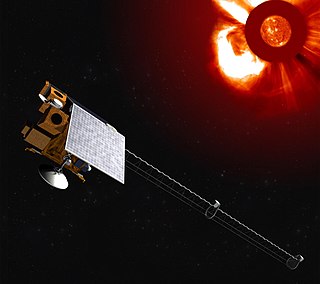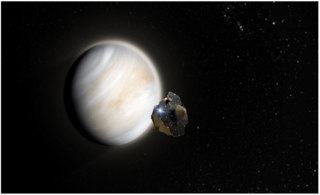
The Laboratory for Atmospheric and Space Physics (LASP) is a research organization at the University of Colorado Boulder. LASP is a research institute with over one hundred research scientists ranging in fields from solar influences, to Earth's and other planetary atmospherics processes, space weather, space plasma and dusty plasma physics. LASP has advanced technical capabilities specializing in designing, building, and operating spacecraft and spacecraft instruments.

The following outline is provided as an overview of and topical guide to space exploration.

The National Aeronautics and Space Administration is an independent agency of the U.S. federal government responsible for the civil space program, aeronautics research, and space research. Established in 1958, it succeeded the National Advisory Committee for Aeronautics (NACA) to give the U.S. space development effort a distinctly civilian orientation, emphasizing peaceful applications in space science. It has since led most American space exploration, including Project Mercury, Project Gemini, the 1968–1972 Apollo Moon landing missions, the Skylab space station, and the Space Shuttle. It currently supports the International Space Station and oversees the development of the Orion spacecraft and the Space Launch System for the crewed lunar Artemis program, the Commercial Crew spacecraft, and the planned Lunar Gateway space station.

Space research is scientific study carried out in outer space, and by studying outer space. From the use of space technology to the observable universe, space research is a wide research field. Earth science, materials science, biology, medicine, and physics all apply to the space research environment. The term includes scientific payloads at any altitude from deep space to low Earth orbit, extended to include sounding rocket research in the upper atmosphere, and high-altitude balloons.

The Interstellar Mapping and Acceleration Probe(IMAP) is a heliophysics mission that will simultaneously investigate two important and coupled science topics in the heliosphere: the acceleration of energetic particles and interaction of the solar wind with the local interstellar medium. These science topics are coupled because particles accelerated in the inner heliosphere play crucial roles in the outer heliospheric interaction. In 2018, NASA selected a team led by David J. McComas of Princeton University to implement the mission, which is currently planned to launch in late April to late May 2025. IMAP will be a Sun-tracking spin-stabilized satellite in orbit about the Sun–Earth L1 Lagrange point with a science payload of ten instruments. IMAP will also continuously broadcast real-time in-situ data that can be used for space weather prediction.
NASA's Solar Terrestrial Probes program (STP) is a series of missions focused on studying the Sun-Earth system. It is part of NASA's Heliophysics Science Division within the Science Mission Directorate.

The Comet Interceptor is a robotic spacecraft mission led by the European Space Agency (ESA) planned for launch in 2029. The spacecraft will be "parked" at the Sun-Earth L2 point and wait for up to three years for a long-period comet to fly by at a reachable trajectory and speed.
Cosmic Vision is the third campaign of space science and space exploration missions in the Science Programme of the European Space Agency (ESA). Formulated in 2005 as Cosmic Vision: Space Science for Europe 2015–2025, the campaign succeeded the Horizon 2000 Plus campaign and envisioned a number of missions in the fields of astronomy and solar system exploration beyond 2015. Ten missions across four funding categories are planned to be launched under Cosmic Vision, with the first being CHEOPS in December 2019. A mission to the Galilean moons (JUICE), the first deep space mission with an opportunistic target, and one of the first gravitational-wave space observatories (LISA), are planned for launch as part of the Cosmic Vision campaign.
Solar Cruiser was a planned NASA spacecraft that would have studied the Sun while propelled by a solar sail. The mission would have supported NASA's Solar Terrestrial Probes program by studying how interplanetary space changes in response to the constant outpouring of energy and particles from the Sun and how it interacts with planetary atmospheres. It was expected to launch as a rideshare payload alongside IMAP in February 2025. However, the spacecraft was not selected for further development and project closeout efforts concluded in 2023.

Space Weather Follow On-Lagrange 1 (SWFO-L1) is a future spacecraft mission planned to monitor signs of solar storms, which may pose harm to Earth's telecommunication network. The spacecraft will be operated by the National Oceanic and Atmospheric Administration (NOAA), with launch scheduled for 31 March 2025. It is planned to be placed at the Sun–Earth L1 Lagrange point, a location between the Earth and the Sun. This will allow SWFO-L1 to continuously watch the solar wind and energetic particles heading for Earth. SWFO-L1 is an ESPA Class Spacecraft, sized for launch on an Evolved Expendable Launch Vehicle Secondary Payload Adapter (ESPA) Grande ring in addition to the rocket's primary payload. The spacecraft's Solar Wind Instrument Suite (SWIS) which includes three instruments will monitor solar wind, and the Compact Coronagraph (CCOR) will monitor the Sun's surroundings to image coronal mass ejection (CME). A CME is a large outburst of plasma sent from the Sun towards interplanetary space.

The GUSTO mission is a high-altitude balloon mission that carries an infrared telescope to measure fine-structure line emission from the interstellar medium. The mission was developed by NASA's Explorers Program, and was launched in December 2023 from Antarctica.

Photon is a satellite bus based on Rocket Lab's kick stage.
Shensuo, formerly Interstellar Express is a proposed Chinese National Space Administration program designed to explore the heliosphere and interstellar space. The program will feature two or three space probes that will purportedly be launched in 2024 and follow differing trajectories to encounter Jupiter to assist them out of the Solar System. The first probe, IHP-1, will travel toward the nose of the heliosphere, while the second probe, IHP-2, will fly near to the tail, skimming by Neptune and Triton in January 2038. There may be another probe—tentatively IHP-3—which would launch in 2030 to explore to the northern half of the heliosphere. IHP-1 and IHP-2 would be the sixth and seventh spacecraft to leave the Solar System, as well as first non-NASA probes to achieve this status.

Venus Life Finder is a planned uncrewed spacecraft to Venus designed to detect signs of life in the Venusian atmosphere. The first private Venus mission, the spacecraft is being developed by Rocket Lab in collaboration with a team from the Massachusetts Institute of Technology. The spacecraft will consist of a Photon Explorer cruise stage which will send a small atmospheric probe into Venus with a single instrument, an autofluorescing nephelometer, to search for organic compounds within Venus' atmosphere.









